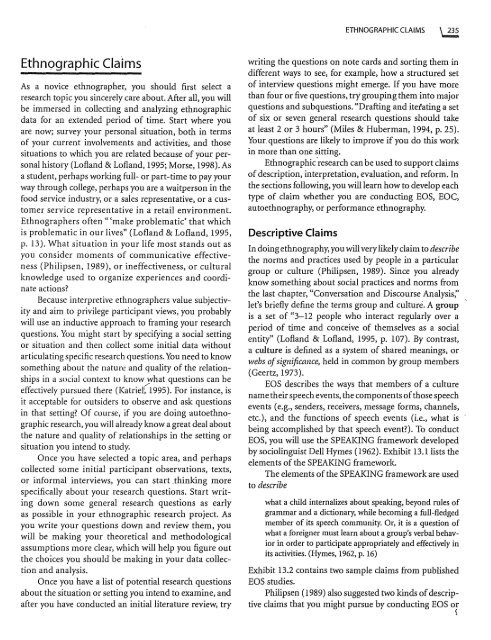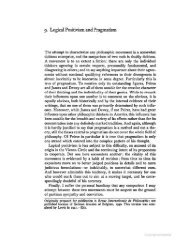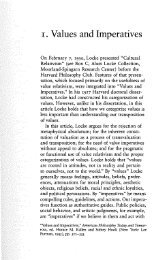Ethnographic Research - Matthew J. Brown
Ethnographic Research - Matthew J. Brown
Ethnographic Research - Matthew J. Brown
- No tags were found...
Create successful ePaper yourself
Turn your PDF publications into a flip-book with our unique Google optimized e-Paper software.
ETHNOGRAPHIC CLAIMS \ 235<strong>Ethnographic</strong> ClaimsAs a novice ethnographer, you should first select aresearch topic you sincerely care about. After all, you willbe immersed in collecting and analyzing ethnographicdata for an extended period of time. Start where youare now; survey your personal situation, both in termsof your current involvements and activities, and thosesituations to which you are related because of your personalhistory (Lofland & Lofland, 1995; Morse, 1998).Asa student, perhaps working full- or part-time to pay yourway through college, perhaps you are a waitperson in thefood service industry, or a sales representative, or a customerservice representative in a retail environment.Ethnographers often "'make problematic' that whichis problematic in our lives" (Lofland & Lofland, 1995,p. 13). What situation in your life most stands out asyou consider moments of communicative effectiveness(Philipsen, 1989), or ineffectiveness, or culturalknowledge used to organize experiences and coordinateactions?Because interpretive ethnographers value subjectivityand aim to privilege participant views, you probablywill use an inductive approach to framing your researchquestions. You might start by specifying a social settingor situation and then collect some initial data withoutarticulating specific research questions. You need to knowsomething about the nature and quality of the relationshipsin a social context to know what questions can beeffectively pursued there (Katrie(1995). For instance, isit acceptable for outsiders to observe and ask questionsin that setting? Of course, if you are doing autoethnographicresearch, you will already know a great deal aboutthe nature and quality of relationships in the setting orsituation you intend to study.Once you have selected a topic area, and perhapscollected some initial participant observations, texts,or informal interviews, you can start thinking morespecifically about your research questions. Start writingdown some general research questions as earlyas possible in your ethnographic research project. Asyou write your questions down and review them, youwill be making your theoretical and methodologicalassumptions more clear, which will help you figure outthe choices you should be making in your data collectionand analysis.Once you have a list of potential research questionsabout the situation or setting you intend to examine, andafter you have conducted an initial literature review, trywriting the questions on note cards and sorting them indifferent ways to see, for example, how a structured setof interview questions might emerge. If you have morethan four or five questions, try grouping them into majorquestions and subquestions. "Drafting and itetating a setof six or seven general research questions should takeat least 2 or 3 hours" (Miles & Huberman, 1994, p. 25).Your. questions are likely to improve if you do this workin more than one sitting.<strong>Ethnographic</strong>'research can be used to support claimsof description, interpretation, evaluation, and reform. Inthe sections following, you will learn how to develop eachtype of claim whether you are conducting EOS, EOC,autoethnography, or performance ethnography.Descriptive ClaimsIn doing ethnography, you will very likely claim to describethe norms and practices used by people in a particulargroup or culture (Philipsen, 1989). Since you alreadyknow something about social practices and norms fromthe last chapter, "Conversation and Discourse Analysis:'let's briefly define the terms group and culture. A groupis a set of "3-12 people who interact regularly over aperiod of time and conceive of themselves as a socialentity" (Lofland & Lofland, 1995, p. 107). By contrast,a culture is defined as a system of shared meanings, orwebs of significance, held in common by group members(Geertz, 1973).EOS describes the ways that members of a culturename their speech events, the components of those speechevents (e.g., senders, receivers, message forms, channels,etc.), and the functions of speech events (i.e., what isbeing accomplished by that speech event?). To conductEOS, you will use the SPEAKING framework developedby sociolinguist Dell Hymes (1962). Exhibit l3.1lists theelements of the SPEAKING framework.The elements of the SPEAKING framework are usedto describewhat a child internalizes about speaking, beyond rules ofgrammar and a dictionary, while becoming a full-fledgedmember of its speech community. Or, it is a question ofwhat a foreigner must learn about a group's verbal behaviorin order to participate appropriately and effectively inits activities. (Hymes, 1962, p. 16)Exhibit l3.2 contains two sample claims from publishedEOS studies.Philipsen (1989) also suggested two kinds of descriptiveclaims that you might pursue by conducting EOS ori






